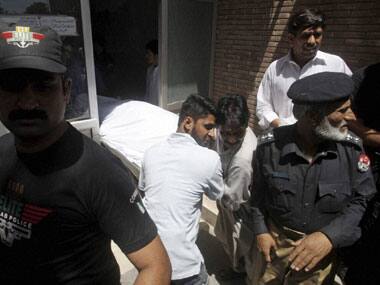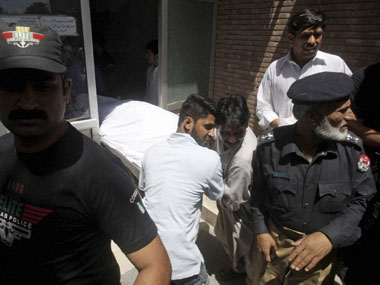The death of Sarabjit Singh in a Pakistani hospital, announced in the wee hours of 2 May, conveys a dangerous portent to the Indian strategic establishment at a time when the ongoing Chinese incursion in Depsang Valley of Ladakh has already entered its third week. It conveys that the much-feared pincer threat to Indian geopolitical interests from Pakistan and China may well become a reality in the near future if India does not take effective preventive measures in double quick time. [caption id=“attachment_747751” align=“alignleft” width=“380”]
 The body of Sarabjit Singh is brought out of a Pakistan hospital. PTI[/caption] Sarabjit’s death is nothing but an extra judicial killing, possibly choreographed by Lashkar-e-Toiba (LeT) and Tehreek-e-Taliban Pakistan (TTP). Of the two Pakistani non-state actors, the former has been a major bug bear for India for a long time, while the latter has been Pakistan-centric in its terrorist activities. The two outfits’ cadres possibly acted in unison in the murderous assault on Sarabjit on 26 April in Lahore’s Kot Lakhpat jail while the jail officials turned a blind eye to the attack. Sarabjit was no ordinary prisoner in Kot Lakhpat, a jail meant to lodge four thousand prisoners but is housing over 17,000 prisoners. He was on death row which means a separate cell for him and very difficult and multi-layered system for his access. There is no way that the seven attackers (two of whom supposedly have links to terror organisations) armed with iron rods, bricks and other improvised weapons could have gained access to him without the jail officials themselves flinging his cell doors open for the marauders. The colluding jail officials could not dare to do what they did in normal circumstances. But then these were hardly ’normal’ circumstances and hawks in the Pakistani defence establishment (read the notorious Inter Services Intelligence) were baying for Sarabjit’s blood and score a brownie point over the Indians after the hangings of Ajmal Kasab (21 November, 2012) and Afzal Guru (9 February 2013). Therefore, once the powerful military establishment of the country decides that Sarabjit has to be expended, all it required to do was to give a hands-off signal to the Kot Lakhpat jail officials as their agents masquerading as prisoners finish the job. It will be interesting to see what happens to Sarabjit’s seven attackers. No, no, this writer is not talking about whether any action would be taken against them. India should not entertain such thoughts even though the Ministry of External Affairs has demanded that the Pakistani government conducts a thorough investigation to identify those responsible for the attack and ensure that they are punished. This is not going to happen. The most likely scenario is that the seven attackers will simply melt into thin air, sooner or later. Indian intelligence apparatus will do well to keep a hawk’s eye on the whereabouts of Sarabjit killers and dig up an entire data base on them. These seven killers are the only route available for India to build up a dossier on them, collect clues (if possible, evidence, which obviously would be like pinching a hair of the moustache of a sleeping lion) and expose Pakistan before the international community. Implications of LeT-TTP combination for India Now let us turn to the original point: how the use of the LeT-TTP combination for carrying out Sarabjit’s extra judicial killing can a bad portent for India. This writer is not aware of a single joint operation by the LeT and the TTP against Indian interests. The question is: whether a nuptial of sorts has been performed by the two Pakistani non state actors or whether it was just a one-off arrangement cobbled up by their mentors in the Pakistani military establishment to hit at Indian interests? The LeT and the TTP are radically different in their approach and ideology. The LeT is turning global while keeping its anti-India operations very high on their agenda. The TTP, on the other hand, has of late emerged as Pakistan’s single biggest security nightmare which is ironically nurtured and replenished in Pakistan’s areas bordering Afghanistan. Their getting together, even if for a one-off India-specific operation, would not have gone unnoticed by the Indian intelligence establishment. A question worth examining would be whether Pakistani military establishment has brokered some secret deal with the TTP or some elements of the TTP. The China factor Now couple it with obscure Chinese moves vis a vis India in the recent years which have been like an iceberg constantly expanding under water. The Chinese incursion in Lepsang Valley of Ladakh since 15 April may well be just a tip of this dangerous iceberg. The Chinese have for some years silently knocked off the western sector boundary from the Sino-Indian boundary disputes talks. China has unilaterally rewritten the ground rules for the boundary talks with India and excluded Jammu and Kashmir from the total length of Line of Actual Control, thus clearly questioning Indian sovereignty on Jammu and Kashmir. The Sarabjit issue and the ongoing Chinese incursion in Ladakh are not inter-related per se. But the two developments ring an alarm bell for the Indian strategic establishment. Are China and Pakistan working in tandem and moving in a pincer formation to increase the heat on India? The writer is a Firstpost columnist and a strategic analyst. He can be reached at: bhootnath004@yahoo.com.
The body of Sarabjit Singh is brought out of a Pakistan hospital. PTI[/caption] Sarabjit’s death is nothing but an extra judicial killing, possibly choreographed by Lashkar-e-Toiba (LeT) and Tehreek-e-Taliban Pakistan (TTP). Of the two Pakistani non-state actors, the former has been a major bug bear for India for a long time, while the latter has been Pakistan-centric in its terrorist activities. The two outfits’ cadres possibly acted in unison in the murderous assault on Sarabjit on 26 April in Lahore’s Kot Lakhpat jail while the jail officials turned a blind eye to the attack. Sarabjit was no ordinary prisoner in Kot Lakhpat, a jail meant to lodge four thousand prisoners but is housing over 17,000 prisoners. He was on death row which means a separate cell for him and very difficult and multi-layered system for his access. There is no way that the seven attackers (two of whom supposedly have links to terror organisations) armed with iron rods, bricks and other improvised weapons could have gained access to him without the jail officials themselves flinging his cell doors open for the marauders. The colluding jail officials could not dare to do what they did in normal circumstances. But then these were hardly ’normal’ circumstances and hawks in the Pakistani defence establishment (read the notorious Inter Services Intelligence) were baying for Sarabjit’s blood and score a brownie point over the Indians after the hangings of Ajmal Kasab (21 November, 2012) and Afzal Guru (9 February 2013). Therefore, once the powerful military establishment of the country decides that Sarabjit has to be expended, all it required to do was to give a hands-off signal to the Kot Lakhpat jail officials as their agents masquerading as prisoners finish the job. It will be interesting to see what happens to Sarabjit’s seven attackers. No, no, this writer is not talking about whether any action would be taken against them. India should not entertain such thoughts even though the Ministry of External Affairs has demanded that the Pakistani government conducts a thorough investigation to identify those responsible for the attack and ensure that they are punished. This is not going to happen. The most likely scenario is that the seven attackers will simply melt into thin air, sooner or later. Indian intelligence apparatus will do well to keep a hawk’s eye on the whereabouts of Sarabjit killers and dig up an entire data base on them. These seven killers are the only route available for India to build up a dossier on them, collect clues (if possible, evidence, which obviously would be like pinching a hair of the moustache of a sleeping lion) and expose Pakistan before the international community. Implications of LeT-TTP combination for India Now let us turn to the original point: how the use of the LeT-TTP combination for carrying out Sarabjit’s extra judicial killing can a bad portent for India. This writer is not aware of a single joint operation by the LeT and the TTP against Indian interests. The question is: whether a nuptial of sorts has been performed by the two Pakistani non state actors or whether it was just a one-off arrangement cobbled up by their mentors in the Pakistani military establishment to hit at Indian interests? The LeT and the TTP are radically different in their approach and ideology. The LeT is turning global while keeping its anti-India operations very high on their agenda. The TTP, on the other hand, has of late emerged as Pakistan’s single biggest security nightmare which is ironically nurtured and replenished in Pakistan’s areas bordering Afghanistan. Their getting together, even if for a one-off India-specific operation, would not have gone unnoticed by the Indian intelligence establishment. A question worth examining would be whether Pakistani military establishment has brokered some secret deal with the TTP or some elements of the TTP. The China factor Now couple it with obscure Chinese moves vis a vis India in the recent years which have been like an iceberg constantly expanding under water. The Chinese incursion in Lepsang Valley of Ladakh since 15 April may well be just a tip of this dangerous iceberg. The Chinese have for some years silently knocked off the western sector boundary from the Sino-Indian boundary disputes talks. China has unilaterally rewritten the ground rules for the boundary talks with India and excluded Jammu and Kashmir from the total length of Line of Actual Control, thus clearly questioning Indian sovereignty on Jammu and Kashmir. The Sarabjit issue and the ongoing Chinese incursion in Ladakh are not inter-related per se. But the two developments ring an alarm bell for the Indian strategic establishment. Are China and Pakistan working in tandem and moving in a pincer formation to increase the heat on India? The writer is a Firstpost columnist and a strategic analyst. He can be reached at: bhootnath004@yahoo.com.
Consulting Editor, First Post. Strategic analyst. Political commentator. Twitter handle @Kishkindha.
)